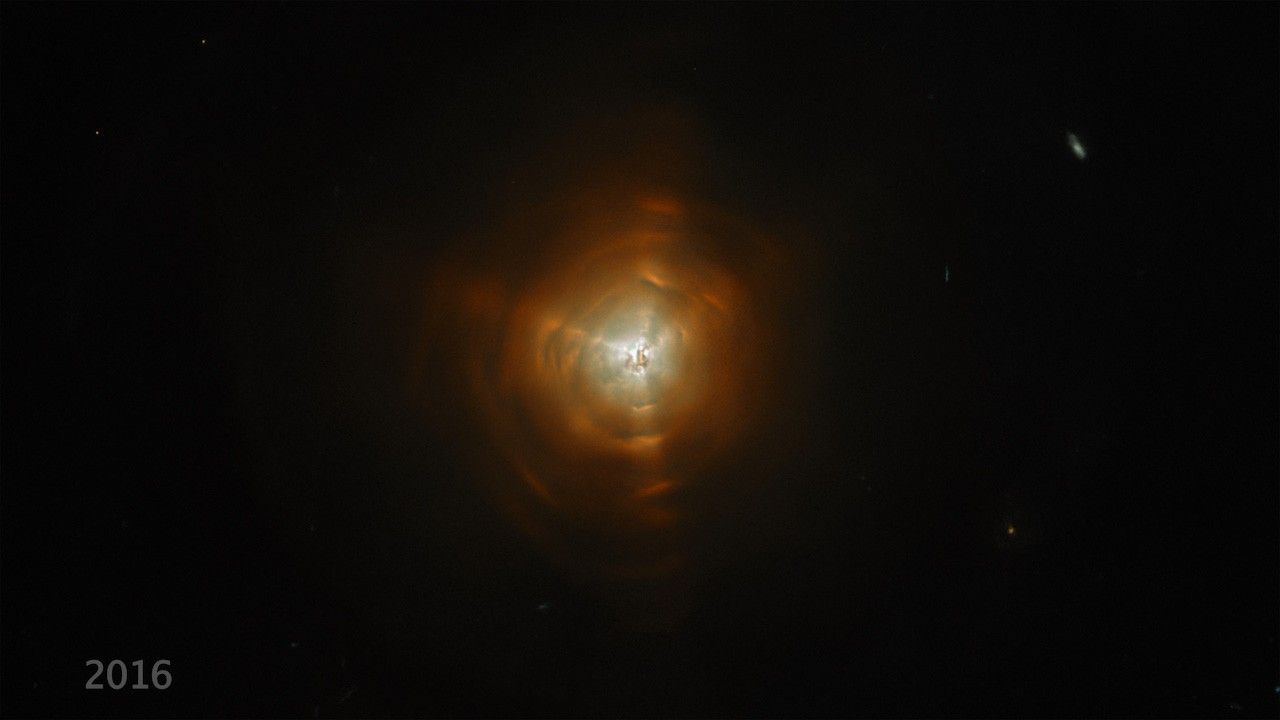1 min read
CW Leonis

A hypnotizing vortex? A peek into a witch's cauldron? A giant space-spider web?
In reality, it's a look at the red giant star CW Leonis as photographed by NASA's Hubble Space Telescope — just in time for celebrating Halloween with creepy celestial sights.
The orange-red "cobwebs" are dusty clouds of sooty carbon engulfing the dying star. They were created from the outer layers of CW Leonis being thrown out into the inky black void. The carbon, cooked up through nuclear fusion in the star's interior, gives it a carbon-rich atmosphere. Blasting the carbon back into space provides raw material for the formation of future stars and planets. All known life on Earth is built around the carbon atom. Complex biological molecules consist of carbon atoms bonded with other common elements in the universe.
At a distance of 400 light-years from Earth, CW Leonis is the closest carbon star. This gives astronomers the chance to understand the interplay between the star and its surrounding, turbulent envelope. The complex inner structure of shells and arcs may be shaped by the star’s magnetic field. Detailed Hubble observations of CW Leonis taken over the last two decades also show the expansion of threads of ejected material around the star.
The bright beams of light radiating outwards from CW Leonis are one of the star's most intriguing features. They've changed in brightness within a 15-year period — an incredibly short timespan in astronomical terms. Astronomers speculate that gaps in the dust shrouding CW Leonis may allow beams of starlight to pierce through and illuminate dust, like searchlight beacons through a cloudy sky. However, the exact cause of the dramatic changes in their brightness is as yet unexplained.
A star shines when the outward pressure from the fusion furnace at the core balances against the crush of gravity. When the star runs out of hydrogen fuel, the persistent pull of gravity causes the star to start collapsing. As the core shrinks, the shell of plasma surrounding the core becomes hot enough to begin fusing hydrogen. In addition, pressures and temperatures in the core rise to the point to ignite helium fusion. This generates enough heat to dramatically expand the star's outer layers and swell up into a bloated red giant.
CW Leonis has an orange-reddish color due to its relatively low surface temperature of 2,300 degrees Fahrenheit. The green-tinted beams of light emanating from the star, however, glow at invisible mid-infrared wavelengths. In the absence of natural color, green has been added to the infrared image for better analysis through color-contrast.
About the Object
- R.A. PositionR.A. PositionRight ascension – analogous to longitude – is one component of an object's position.09:47:57.406
- Dec. PositionDec. PositionDeclination – analogous to latitude – is one component of an object's position.+13 16 43.56
- ConstellationConstellationOne of 88 recognized regions of the celestial sphere in which the object appears.Leo
- DistanceDistanceThe physical distance from Earth to the astronomical object. Distances within our solar system are usually measured in Astronomical Units (AU). Distances between stars are usually measured in light-years. Interstellar distances can also be measured in parsecs.400 light-years
- DimensionsDimensionsThe physical size of the object or the apparent angle it subtends on the sky.Image is 2.4 arcmin across (about 0.2 light-years)
About the Data
- Data DescriptionData DescriptionProposal: A description of the observations, their scientific justification, and the links to the data available in the science archive.
Science Team: The astronomers who planned the observations and analyzed the data. "PI" refers to the Principal Investigator. - InstrumentInstrumentThe science instrument used to produce the data.WFC3/UVIS, WFC3/IR
- Exposure DatesExposure DatesThe date(s) that the telescope made its observations and the total exposure time.04 June 2011, 17 May 2016
- FiltersFiltersThe camera filters that were used in the science observations.F606W, F814W, F098M
- Object NameObject NameA name or catalog number that astronomers use to identify an astronomical object.CW Leonis
- Object DescriptionObject DescriptionThe type of astronomical object.Red giant carbon star
- Release DateOctober 28, 2021
- Science ReleaseHubble Celebrates Halloween With A Glowering, Dying Star
- CreditESA/Hubble, NASA, Toshiya Ueta (University of Denver), Hyosun Kim (KASI)

These images are a composite of separate exposures acquired by the WFC3 instrument on the Hubble Space Telescope. Several filters were used to sample narrow wavelength ranges. The color results from assigning different hues (colors) to each monochromatic (grayscale) image associated with an individual filter. In this case, the assigned colors are: Cyan: F606WOrange: F814WGreen: F098M

Related Images & Videos

Carbon Star CW Leonis Dissolve Sequence
This is a time-lapse set of images of the aging red giant star CW Leonis, taken on three dates: 2001, 2011, and 2016. The star is embedded inside gossamer cobwebs of dust encircling the star. These are really shells of carbon dust blown off the star. As they expand into space...
Share
Details
Claire Andreoli
NASA’s Goddard Space Flight Center
Greenbelt, Maryland
claire.andreoli@nasa.gov
































